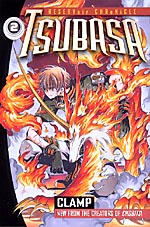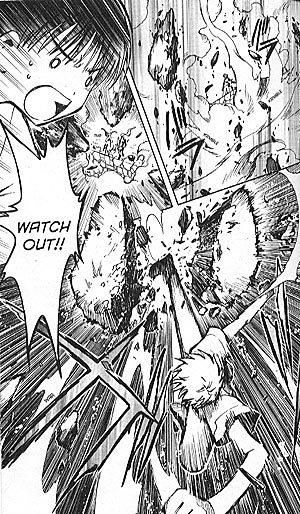 By CLAMP
By CLAMP
208 pages, black and white
Published by Del Rey
I was more than a little hesitant about reading Tsubasa, one of the comic collective CLAMP’s new series now being published in both Japan as well as North America. The gimmick of the series made me think that as someone who hasn’t read the majority of CLAMP’s work, I’d be utterly lost, since it features characters and situations from many of their previous books. I was pretty surprised, then, to discover that not only was I doing just fine in comprehending it… but that I was enjoying the series to boot.
In the Kingdom of Clow, Syaoran is in love with Princess Sakura, but everything changes when a mysterious chamber transforms all of Sakura’s memories into feathers and scatters them across the dimensions. Now Syaoran, along with two other dimensional refugees, must journey from one world to the next to find Sakura’s missing memories in order to save her life. The only catch is that the price Syaoran had to pay for being able to travel the dimensions was steep: Sakura will never regain her happy memories of her life with Syaoran before the accident.
In the back of each volume of Tsubasa is a helpful index that explains references to previous series and what they mean. To my surprise, though, I found that I didn’t really need them at all. Now don’t get me wrong, it’s nice to know what series the strange little white and black rabbits that help find the feathers are originally from, by way of example, or that analogues of a character originally appeared in a different series. But CLAMP makes sure that it’s not information that you actually need. Thanks to characters being from different dimensions and realities, situations are actually new to all of the characters in Tsubasa, meaning that if anything is important it will get explained in the story itself. The rest? Strictly background material, a nod to long-time fans. After all, even the two lead characters of Syaoran and Sakura are alternate-dimension versions of characters from Cardcaptor Sakura, but since they’re from another world, you don’t need to know anything at all about their counterpart’s adventures. Once you get past this information, the rest of Tsubasa is fun. CLAMP brings Syaoran and company into interesting different worlds, while beginning to build up an overarching plot to no doubt keep the series from devolving into a “strange new alternate dimension of the week” formula. The supporting cast is still a little underdeveloped, but there’s enough story material hinted at in their introductions that hopefully we’ll get to know them a bit more before too long.
 What I’m not quite as crazy about in Tsubasa is the art style. Being a four-person comic collective, CLAMP’s projects vary in their look in part based on which creator has taken the lead role for the book. So while I’ve quickly identified over the years that it’s Mick Nekoi whose art I like the most (Wish, Suki: A Like Story, and the upcoming Legal Drug), some of the other CLAMP artists just aren’t quite to my liking. Tsubasa‘s art is almost frustrating, because every time I keep thinking that it’s working, it doesn’t. In the smaller, quieter scenes of Tsubasa it all comes together, the thick ink lines forming an attractive, rough-hewn look to the book that brings the emotionally charged scenes to life. It’s the big action scenes where it all seems to fall apart; every time a big two-page shot would appear, I’d have to stare at the page for several minutes to figure out what was going on. The pages just look cluttered and confusing, and that’s exactly what you don’t want in a fast-moving sequence of events. When Syaoran is fighting the other Kudan spirits in the second volume, I couldn’t help but get frustrated because what should have been so good was an actual effort to push through.
What I’m not quite as crazy about in Tsubasa is the art style. Being a four-person comic collective, CLAMP’s projects vary in their look in part based on which creator has taken the lead role for the book. So while I’ve quickly identified over the years that it’s Mick Nekoi whose art I like the most (Wish, Suki: A Like Story, and the upcoming Legal Drug), some of the other CLAMP artists just aren’t quite to my liking. Tsubasa‘s art is almost frustrating, because every time I keep thinking that it’s working, it doesn’t. In the smaller, quieter scenes of Tsubasa it all comes together, the thick ink lines forming an attractive, rough-hewn look to the book that brings the emotionally charged scenes to life. It’s the big action scenes where it all seems to fall apart; every time a big two-page shot would appear, I’d have to stare at the page for several minutes to figure out what was going on. The pages just look cluttered and confusing, and that’s exactly what you don’t want in a fast-moving sequence of events. When Syaoran is fighting the other Kudan spirits in the second volume, I couldn’t help but get frustrated because what should have been so good was an actual effort to push through.
It’s a little ironic: the story was the part I was afraid that people would have trouble following, and it was the reverse that was true. Tsubasa is a well-written book, and based on that alone I do recommend it. Hopefully the art will eventually catch up to match the writing, though, because right now the two aren’t operating at quite the same levels.
Purchase Links:
